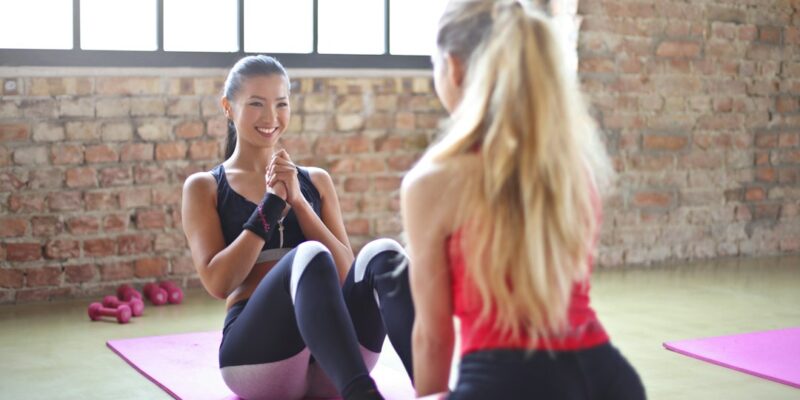
Knock Out Your Fitness Goals with this Cardio Boxing Workout Regimen
Cardio boxing is a high-intensity workout that combines boxing techniques with cardiovascular exercises. It is a great way to improve your overall fitness level while also learning self-defense skills. Incorporating cardio boxing into your fitness routine can provide numerous benefits, including improved cardiovascular health, increased strength and endurance, weight loss and body toning, as well as stress relief and mental health benefits.
Key Takeaways
- Cardio boxing is a high-intensity workout that combines boxing techniques with cardio exercises.
- Benefits of cardio boxing include improved cardiovascular health, increased strength and endurance, and stress relief.
- Essential equipment for cardio boxing includes gloves, hand wraps, and a punching bag or focus mitts.
- Basic boxing techniques include jabs, crosses, hooks, and uppercuts, and footwork is also important.
- Warm-up and cool-down exercises should be included in every cardio boxing workout, such as jumping jacks and stretching.
Benefits of Cardio Boxing for Fitness Goals
One of the main benefits of cardio boxing is improved cardiovascular health. The high-intensity nature of the workout helps to increase your heart rate and improve your cardiovascular endurance. Regular cardio boxing sessions can help to strengthen your heart and lungs, leading to better overall cardiovascular health.
In addition to cardiovascular benefits, cardio boxing also helps to increase strength and endurance. The various punches and movements involved in cardio boxing engage multiple muscle groups, including the arms, shoulders, core, and legs. By consistently practicing cardio boxing, you can build lean muscle mass and improve your overall strength and endurance.
Another benefit of cardio boxing is weight loss and body toning. The combination of high-intensity cardio exercises and strength training movements helps to burn calories and fat, leading to weight loss. Additionally, the repetitive punching movements help to tone and sculpt the muscles in your arms, shoulders, and core.
Cardio boxing is also a great way to relieve stress and improve mental health. The intense physical activity releases endorphins, which are known as “feel-good” hormones that can boost your mood and reduce stress levels. Additionally, the focus required during a cardio boxing workout can help to clear your mind and improve mental clarity.
Essential Equipment and Gear for Cardio Boxing
To get started with cardio boxing, there are a few essential pieces of equipment and gear that you will need. These include:
1. Boxing gloves: Boxing gloves are necessary to protect your hands during the workout. They provide cushioning and support for your punches, reducing the risk of injury.
2. Hand wraps: Hand wraps are used to wrap around your hands and wrists before putting on the boxing gloves. They provide additional support and protection for your hands and wrists.
3. Punching bag or focus mitts: A punching bag or focus mitts are used as targets for your punches. They allow you to practice your technique and improve your accuracy and power.
4. Jump rope: A jump rope is used for warm-up exercises and to improve footwork and coordination. It is an essential tool for cardio boxing workouts.
5. Proper footwear and clothing: It is important to wear comfortable athletic shoes that provide support and stability during the workout. Additionally, wear breathable clothing that allows for freedom of movement.
Basic Boxing Techniques and Movements
| Technique/Movement | Description | Importance |
|---|---|---|
| Jab | A straight punch thrown with the lead hand | Most commonly used punch in boxing, sets up other punches |
| Cross | A straight punch thrown with the rear hand | Powerful punch, used to finish combinations |
| Hook | A punch thrown in a circular motion with the lead or rear hand | Effective for targeting the body or head, adds variety to combinations |
| Uppercut | A punch thrown in an upward motion with the lead or rear hand | Targets the chin or solar plexus, can be used to counter an opponent’s attack |
| Footwork | Movement of the feet to position oneself for offense or defense | Allows for better positioning and balance, helps to avoid opponent’s punches |
| Head movement | Movement of the head to avoid punches | Reduces the likelihood of getting hit, allows for counterpunching opportunities |
Before starting a cardio boxing workout, it is important to learn the basic boxing techniques and movements. These include:
1. Jab, cross, hook, and uppercut punches: These are the fundamental punches in boxing. The jab is a quick straight punch with your lead hand, while the cross is a powerful straight punch with your rear hand. The hook is a circular punch that targets the side of your opponent’s head or body, and the uppercut is an upward punch that targets the chin or body.
2. Footwork and stance: Proper footwork and stance are essential in boxing. The basic stance involves standing with your feet shoulder-width apart, with one foot slightly in front of the other. This allows for better balance and mobility during the workout.
3. Defense techniques: In addition to punches, it is important to learn defensive techniques such as blocking, slipping, and ducking. These techniques help to protect yourself from your opponent’s punches.
Warm-Up and Cool-Down Exercises for Cardio Boxing
Before starting a cardio boxing workout, it is important to warm up your muscles and prepare your body for the intense activity. Some warm-up exercises that are commonly used in cardio boxing include:
1. Dynamic stretching: Dynamic stretching involves moving your muscles through a full range of motion. This helps to increase blood flow and flexibility. Examples of dynamic stretches include arm circles, leg swings, and torso twists.
2. Shadowboxing: Shadowboxing is a technique used to practice boxing movements without a partner or equipment. It helps to warm up your muscles and improve your technique and coordination.
3. Jumping jacks and other cardio exercises: Jumping jacks, high knees, and butt kicks are examples of cardio exercises that can be included in the warm-up. These exercises help to elevate your heart rate and increase blood flow to your muscles.
After completing a cardio boxing workout, it is important to cool down and stretch your muscles to prevent injury and promote recovery. Some cool-down exercises that can be included in a cardio boxing routine include:
1. Static stretching: Static stretching involves holding a stretch for 15-30 seconds. This helps to improve flexibility and reduce muscle soreness. Examples of static stretches include hamstring stretches, quad stretches, and shoulder stretches.
Beginner Cardio Boxing Workout Routine
If you are new to cardio boxing, it is important to start with a beginner workout routine that focuses on proper form and technique. Here is a sample beginner cardio boxing workout routine:
1. Warm-up: Start with 5-10 minutes of dynamic stretching, followed by 5 minutes of shadowboxing.
2. Punching combinations: Practice basic punching combinations such as jab-cross, jab-cross-hook, and jab-cross-hook-uppercut. Perform each combination for 1 minute, with 30 seconds of rest in between.
3. Footwork drills: Practice basic footwork drills such as forward and backward movement, side-to-side movement, and pivoting. Perform each drill for 1 minute, with 30 seconds of rest in between.
4. Cardio exercises: Incorporate cardio exercises such as jumping jacks, high knees, and butt kicks for 1 minute each, with 30 seconds of rest in between.
5. Cool-down: Finish the workout with 5-10 minutes of static stretching.
Intermediate Cardio Boxing Workout Routine
Once you have mastered the basic techniques and movements, you can progress to an intermediate cardio boxing workout routine. This routine incorporates more advanced techniques and movements, as well as higher intensity and longer duration. Here is a sample intermediate cardio boxing workout routine:
1. Warm-up: Start with 10 minutes of dynamic stretching, followed by 10 minutes of shadowboxing.
2. Punching combinations: Perform more advanced punching combinations such as jab-cross-hook-uppercut-hook-cross. Perform each combination for 2 minutes, with 30 seconds of rest in between.
3. Footwork drills: Incorporate more advanced footwork drills such as pivoting and circling your opponent. Perform each drill for 2 minutes, with 30 seconds of rest in between.
4. Cardio exercises: Increase the intensity of the cardio exercises by performing them for 2 minutes each, with 30 seconds of rest in between.
5. Cool-down: Finish the workout with 10-15 minutes of static stretching.
Advanced Cardio Boxing Workout Routine
For those who have reached an advanced level in cardio boxing, it is time to challenge yourself with a more intense workout routine. This routine focuses on speed, power, and endurance, and incorporates sparring and other advanced techniques. Here is a sample advanced cardio boxing workout routine:
1. Warm-up: Start with 15 minutes of dynamic stretching, followed by 15 minutes of shadowboxing.
2. Punching combinations: Perform advanced punching combinations such as jab-cross-hook-uppercut-hook-cross-slip-jab-cross. Perform each combination for 3 minutes, with 30 seconds of rest in between.
3. Footwork drills: Incorporate advanced footwork drills such as pivoting, circling, and changing levels. Perform each drill for 3 minutes, with 30 seconds of rest in between.
4. Sparring: If you have a partner or trainer, incorporate sparring sessions into your workout routine. This allows you to practice your skills in a controlled environment.
5. Cardio exercises: Increase the intensity and duration of the cardio exercises by performing them for 3 minutes each, with 30 seconds of rest in between.
6. Cool-down: Finish the workout with 15-20 minutes of static stretching.
Tips for Maximizing Results with Cardio Boxing
To maximize your results with cardio boxing, consider the following tips:
1. Consistency and dedication: Consistency is key when it comes to seeing results with cardio boxing. Aim to incorporate cardio boxing into your fitness routine at least 2-3 times per week.
2. Proper nutrition and hydration: Fuel your body with nutritious foods and stay hydrated before, during, and after your cardio boxing workouts. This will help to optimize your performance and recovery.
3. Cross-training and variety in workouts: Incorporate other forms of exercise into your fitness routine to prevent boredom and plateauing. Cross-training can help to improve your overall fitness level and prevent overuse injuries.
4. Working with a trainer or partner: Consider working with a trainer or partner who can provide guidance, motivation, and feedback on your technique. They can also help to push you to new levels of intensity and challenge.
Conclusion and Final Thoughts on Cardio Boxing for Fitness Goals
In conclusion, cardio boxing is a highly effective workout regimen that can provide numerous benefits for your fitness goals. It improves cardiovascular health, increases strength and endurance, aids in weight loss and body toning, and provides stress relief and mental health benefits. By incorporating cardio boxing into your fitness routine and following a structured workout plan, you can achieve your fitness goals and improve your overall well-being. Remember to prioritize safety and proper technique, and always consult with a healthcare professional before starting any new exercise program. So, why not give cardio boxing a try and experience the amazing benefits for yourself?
Looking to take your cardio boxing workout regimen to the next level? Check out Wave Magnets, a leading fitness website that offers a wide range of resources and products to enhance your training experience. One article that caught my attention is their guide on “The Benefits of Cardio Boxing for Weight Loss.” This informative piece dives into the science behind how cardio boxing can help you shed those extra pounds while improving your overall fitness. If you’re ready to unleash your inner fighter and achieve your weight loss goals, be sure to give this article a read. (source)
FAQs
What is cardio boxing?
Cardio boxing is a high-intensity workout that combines boxing techniques with cardiovascular exercises to improve overall fitness.
What are the benefits of cardio boxing?
Cardio boxing can help improve cardiovascular health, increase endurance, build strength and agility, and reduce stress.
What equipment do I need for a cardio boxing workout?
You will need boxing gloves, hand wraps, a punching bag, and a jump rope. Some gyms may provide equipment for you.
Is cardio boxing suitable for beginners?
Yes, cardio boxing can be modified to suit all fitness levels. Beginners can start with basic techniques and gradually increase the intensity of their workout.
What are some basic boxing techniques used in cardio boxing?
Some basic techniques include jabs, crosses, hooks, and uppercuts. These techniques can be combined with footwork and defensive moves to create a full-body workout.
How long should a cardio boxing workout last?
A typical cardio boxing workout can last anywhere from 30 minutes to an hour, depending on your fitness level and goals.
Is cardio boxing a good way to lose weight?
Yes, cardio boxing can be an effective way to lose weight and burn calories. It can help you achieve a calorie deficit and increase your metabolism.
What should I wear for a cardio boxing workout?
You should wear comfortable, breathable clothing that allows for a full range of motion. Athletic shoes with good support are also recommended.

















